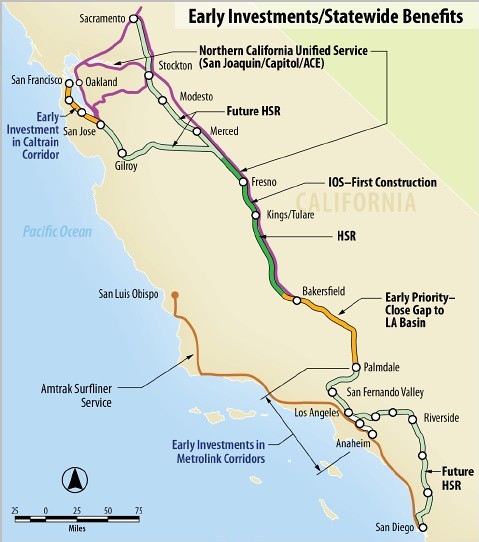 Given the evolving and pressing nature of the California High-Speed Rail story, Mid-Week Links will have to wait until tomorrow.
Given the evolving and pressing nature of the California High-Speed Rail story, Mid-Week Links will have to wait until tomorrow.
High-speed rail dominated the news and blogosphere this week, and for good reason. The California Legislature authorized - barely - releasing $8 billion in bond money so the California High-Speed Rail Authority (CHSRA) could begin construction in the Central Valley. Federal Secretary of Tranportation Ray LaHood applauded the vote, as did transportation advocates, as a step in the right direction for the state and country, though acknowledging there was still another $60 billion to find.
Project opponents pointed to a lawsuit filed the day of the vote by one-time HSR booster Quentin Kopp, who argued the current business plan, which blends high-speed trains with lower-speed commuter rail, is illegal and "mangled", but it didn't do much to dampen advocate's spirits.
The real bomb was let off the day after the vote. The Los Angeles Times reported that French high-speed rail operator SNCF had approached CHSRA with a plan to privately finance and build the state's rail line for a fraction of the cost, though along the I-5 corridor rather than the 99 as currently planned. SNCF, the report claimed, had been declined. Though Yonah Freemark at The Transport Politic had leaked an earlier memo from 2009 on the subject that seems to vindicate CHSRA, the Times piece dealt with a later proposal from 2010.
Steven Smith at Market Urbanism goes into more detail, quoting pro-HSR, anti-CHSRA activist David Schonbrunn that SNCF already actually had private backing in hand, and an anonymous source said the backing was from "major, major US banks", though wouldn't go into specifics. Rather than listen to the SNCF report, Smith's source and Schonbrunn claim it was dismissed out of hand. Construction firm Parsons Brinckerhoff remained at the helm of CHSRA's planning.
Smith speculates CHSRA stuck with the 99 plan for political reasons. For one thing, there are a number of employees working for both CHSRA and Parsons, and it would have been in Parsons' interest to quash the SNCF plan. Another reason is the strong political clout of the eastern Central Valley. Though SNCF had planned spur lines and urban edge stations, located like airports, backers had pushed strongly for including the Central Valley's population centers, and an I-5 alignment, while cheaper, wouldn't have achieved the desired political result.
Alon Levy of Pedestrian Observations approached from a different angle. Not much is known about the SNCF plan, but we do know the cost - $38 billion - and the alignment change - from 99 to existing rights-of-way along I-5. The alignment change alone, he writes, cannot possibly make up the difference between today's $68 billion and the proposal's $38 billion. Rather, most of the cost savings would have to have come from better cost control, thanks to management of the project by an experienced European firm.
Levy's takeaway, like Smith's, is political:
The other lesson we can learn from this episode is political, regarding cost escalations and strategic misrepresentation. Too many political transit supporters downplay the issue. LightRailNow claims that a cost escalation that occurs before construction starts is not a cost escalation, but just a more accurate cost estimate; Robert Cruickshank did not quite say the same when the 2010 business plan for CAHSR revealed costs had doubled, but came close to it by describing the plan as more careful and thorough. In reality, large bombshell reports shortly after money has been obligated are a hallmark of secretive, untrustworthy planning, precisely the kind likeliest to lie about costs.
It's likely the story will continue to unfold as the weeks wear on.
The story from Smith and Levy often spills onto Twitter, so if you're into that kind of thing be sure to follow them @MarketUrbanism and @alonlevy @alon_levy. You can also follow me @theGreaterMarin, though I mostly leave the HSR story to them.